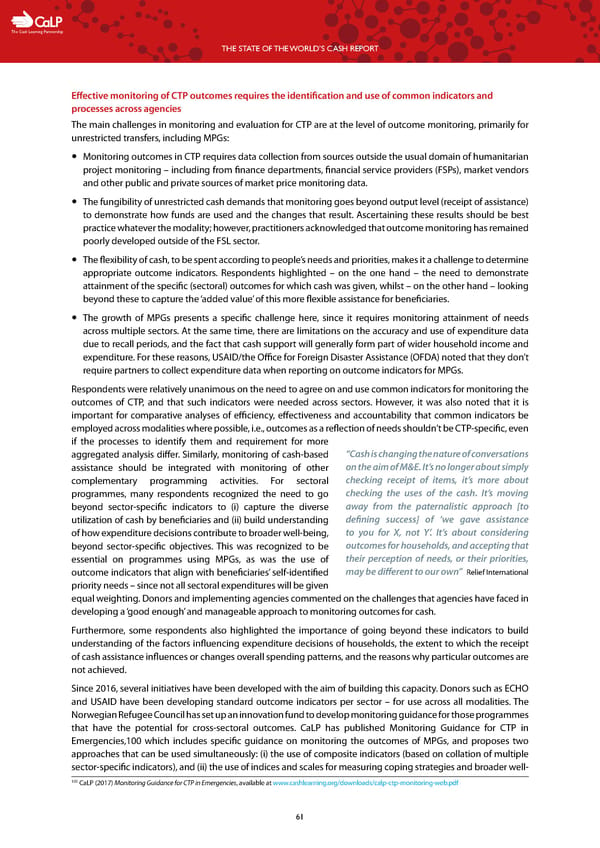C The Cash Learning Partnership THE STATE OF THE WORLD’S CASH REPORT Effective monitoring of CTP outcomes requires the identification and use of common indicators and processes across agencies The main challenges in monitoring and evaluation for CTP are at the level of outcome monitoring, primarily for unrestricted transfers, including MPGs: — Monitoring outcomes in CTP requires data collection from sources outside the usual domain of humanitarian project monitoring – including from finance departments, financial service providers (FSPs), market vendors and other public and private sources of market price monitoring data. — The fungibility of unrestricted cash demands that monitoring goes beyond output level (receipt of assistance) to demonstrate how funds are used and the changes that result. Ascertaining these results should be best practice whatever the modality; however, practitioners acknowledged that outcome monitoring has remained poorly developed outside of the FSL sector. — The flexibility of cash, to be spent according to people’s needs and priorities, makes it a challenge to determine appropriate outcome indicators. Respondents highlighted – on the one hand – the need to demonstrate attainment of the specific (sectoral) outcomes for which cash was given, whilst – on the other hand – looking beyond these to capture the ‘added value’ of this more flexible assistance for beneficiaries. — The growth of MPGs presents a specific challenge here, since it requires monitoring attainment of needs across multiple sectors. At the same time, there are limitations on the accuracy and use of expenditure data due to recall periods, and the fact that cash support will generally form part of wider household income and expenditure. For these reasons, USAID/the Office for Foreign Disaster Assistance (OFDA) noted that they don’t require partners to collect expenditure data when reporting on outcome indicators for MPGs. Respondents were relatively unanimous on the need to agree on and use common indicators for monitoring the outcomes of CTP, and that such indicators were needed across sectors. However, it was also noted that it is important for comparative analyses of efficiency, effectiveness and accountability that common indicators be employed across modalities where possible, i.e., outcomes as a reflection of needs shouldn’t be CTP-specific, even if the processes to identify them and requirement for more aggregated analysis differ. Similarly, monitoring of cash-based “Cash is changing the nature of conversations assistance should be integrated with monitoring of other on the aim of M&E. It’s no longer about simply complementary programming activities. For sectoral checking receipt of items, it’s more about programmes, many respondents recognized the need to go checking the uses of the cash. It’s moving beyond sector-specific indicators to (i) capture the diverse away from the paternalistic approach [to utilization of cash by beneficiaries and (ii) build understanding defining success] of ‘we gave assistance of how expenditure decisions contribute to broader well-being, to you for X, not Y’. It’s about considering beyond sector-specific objectives. This was recognized to be outcomes for households, and accepting that essential on programmes using MPGs, as was the use of their perception of needs, or their priorities, outcome indicators that align with beneficiaries’ self-identified may be different to our own” Relief International priority needs – since not all sectoral expenditures will be given equal weighting. Donors and implementing agencies commented on the challenges that agencies have faced in developing a ‘good enough’ and manageable approach to monitoring outcomes for cash. Furthermore, some respondents also highlighted the importance of going beyond these indicators to build understanding of the factors influencing expenditure decisions of households, the extent to which the receipt of cash assistance influences or changes overall spending patterns, and the reasons why particular outcomes are not achieved. Since 2016, several initiatives have been developed with the aim of building this capacity. Donors such as ECHO and USAID have been developing standard outcome indicators per sector – for use across all modalities. The Norwegian Refugee Council has set up an innovation fund to develop monitoring guidance for those programmes that have the potential for cross-sectoral outcomes. CaLP has published Monitoring Guidance for CTP in Emergencies,100 which includes specific guidance on monitoring the outcomes of MPGs, and proposes two approaches that can be used simultaneously: (i) the use of composite indicators (based on collation of multiple sector-specific indicators), and (ii) the use of indices and scales for measuring coping strategies and broader well- 100 CaLP (2017) Monitoring Guidance for CTP in Emergencies, available at www.cashlearning.org/downloads/calp-ctp-monitoring-web.pdf 61
 The State of the World's Cash | Full Report Page 62 Page 64
The State of the World's Cash | Full Report Page 62 Page 64